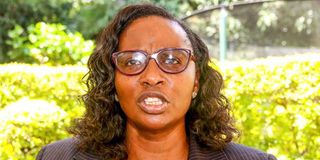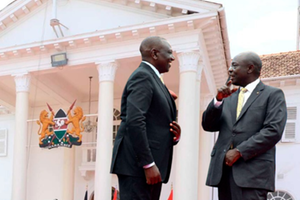‘Tiny’ academies in slums should be merged, says Dagoretti North MP Beatrice Elachi

Dagoretti North MP Beatrice Elachi. Ms Elachi calling for more substantive learner populations in slum areas.
What you need to know:
- Whether Ms Elachi’s war against mushrooming academies will spark an introspection into the school licensing environment will be a matter of wait-and-see.
- As per the Education ministry guidelines, a classroom in an ideal school should have a maximum of 45 learners. Each learner should have a space of 1.2 square metres around them.
- To register a private school, you are required to pay Sh10,000 as a registration fee to the Education Principal Secretary every five years. A public school should pay Sh2,000.
It is 4 pm and uniformed young learners are heading home from school in Nairobi’s Dagoretti North. Some are alone; some are with their siblings.
But the school they are coming from has many question marks about it. It is an iron sheet structure without a playing field and the total pupil population is barely 60. Almost half of the teachers in the school, which is squeezed in-between rental houses, are untrained.
The area MP, Ms Beatrice Elachi, detests such “tiny” schools. She groups them in the category of informal schools. “We have informal schools where we have 50 children in one school and 70 in another. And we’re just wondering: is it right for these children? Is that the right set-up of schools that we need?” she posed at a public forum last year.
In a subsequent interview with the Saturday Nation, she said it is unhealthy to have small schools all over the area.
“You find 100 children in one school; 200 in another; 70 in another; 50 in another. I want to plead with them: with this new system (Competency-Based Curriculum), we have to be very careful. It is a system that is really hands-on, and it is my plea to some of the schools: if you know your school has 50 or 70 kids, try and join with the other private schools and see how you can work together in a consortium. Put the learners where there are more children for purposes of learning,” she said.
Such schools are growing because, much as the government policy is that public schools are free, often parents are required to pay up some amounts.
In our interviews with some parents in Nairobi, we were told of head teachers charging as much as Sh8,000 to admit a child to a public school. That child is also required to pay for meals and meet other costs throughout his or her stay at the school.
Due to those costs and the overcrowding in public schools, the mushrooming “tiny” academies have become a welcome alternative to the urban poor. They appear relatively cheaper and because they are closer to residences and they sell themselves as private schools, some parents prefer them.
'A bad joke'
But with policymakers like Ms Elachi calling for more substantive learner populations, might we see a change? Ms Elachi calls some of the mabati schools ‘a joke; a bad joke’.
“During our times, we never used to have all these things,” she said. “I will support a school that has at least 200 students and which has good structures.”
She went on: “But we cannot support a school which has just taken a mabati (structure) and in that mabati you want to tell me now it’s a class. How will even the CDF (Constituency Development Fund) support you?”
“Don’t put a school where there is a busaa or chang’aa den. Then, you are not helping those children. Put up a school where the environment is good,” the MP further observed.
Historically, slums in Nairobi and other urban areas in Kenya have been known to have a category of schools not known in rural areas — non-formal schools.
In the eyes of the government, non-formal schools are like village polytechnics, only that they are meant for younger learners and learners who are willing to learn can advance to proper primary schools. They are supposed to teach primary school-level learners to read and write and also to impart technical skills like tailoring and carpentry. They are meant for children who missed going to conventional schools for one reason or another.
In fact, there is a government policy on non-formal schools released in 2021. It is titled Guidelines for Basic Education Institutions 2021. In the policy, they are referred to as Alternative Provision of Basic Education and Training (Apbet) institutions.
However, according to Dr Onesmus Kiminza, a retired policy director at the Ministry of Education who developed the policy, some schools in urban areas are basically low-cost academies that pretend to be non-formal schools.
“The proper non-formal schools were started in the informal settlements by churches or other people who had goodwill and were not charging anything. But there is the context of the low-cost private schools which have emerged and are calling themselves non-formal,” he said.
“Non-formal schools, in the context in which it was defined by the ministry, are institutions that were offering both regular and functional education programmes for children under difficult circumstances who, first of all, did not have time (to attend school).
They perhaps enrolled late and did not have time to attend regular classes because of their backgrounds. Perhaps they wanted time off to go and fend for their siblings or they were coming from the informal settlements and the families were struggling and they needed to go out and fend for themselves,” added Dr Kiminza.
He went on: “In the normal non-formal curriculum according to the government definition, you do not need to do eight years. You can do four years and finish. It is because these are mature children who know what they want.”
Learner population
But in his opinion, a school should not be judged by the learner population.
“If you look at the definition of a school in the Basic Education Act, it is where children assemble to receive instruction. And the instructions must be guided by the policy. So, even when 50 children assemble in a formal set-up and are following a structured curriculum, that should be a school. But it also depends on who is giving the instructions, because you can assemble them and you pick an unqualified teacher,” he said.
Whether Ms Elachi’s war against mushrooming academies will spark an introspection into the school licensing environment will be a matter of wait-and-see. What does a person need to start a school? As per the Education ministry guidelines, a classroom in an ideal school should have a maximum of 45 learners. Each learner should have a space of 1.2 square metres around them.
To register a private school, you are required to pay Sh10,000 as a registration fee to the Education Principal Secretary every five years. A public school should pay Sh2,000.
Academies with mabati structures are often teetering on the brink of non-conformity because of what the requirements say of ideal structures.
“The structures must be secure and adhere to the building standards as prescribed by the Public Works Department, as well as all other regulations on safety in force at the time of registration,” the guidelines say.
Crack whip
To ensure learners go to proper schools, Dr Kiminza opined that the government needs to crack the whip on the fees levied by public schools to ensure children get truly free education.
“When regular (public) schools are charging – and they are charging even more than the low-cost private ones – many parents will choose to take their children to the low-cost private schools,” he said.
In response to Ms Elachi’s view on withdrawing support from ‘tiny’ academies, Dr Kiminza thinks the best solution is to have schools that offer not just literacy and numeracy but also technical skills in informal settlements.
With such schools, he said, if the children drop out, they will at least have some knowledge to help them earn a living. And if they wish to continue with their education, they can go to proper primary schools.
Ms Elachi’s onslaught might also not catch on because parents are in praise of private schools. Dagoretti North residents interviewed by the Saturday Nation were largely in defence of private schools, no matter their size.
“They help reduce the population in public schools. If you look at public primary schools like Kawangware and Gatina, you have hundreds of pupils per class. One teacher can’t handle all those, and they better have another way of getting an education,” said Patrick Mwangi, a snacks seller in Kawangware.
Samuel Ndung’u, a boda boda rider, was of the same opinion. “One thing I am sure of is that I can’t take my child to a kanjo school (public schools founded by the city council), given the numbers... But these kanjo school children, ni Mungu tu (only God can help),” he said.
For Ronald Mokaya, another boda boda rider, private schools fare better because teachers are more accountable for their time. “If public school teachers followed strictly on their duty rosters, they would also be okay. But that’s where private schools outdo the public ones,” he said.
“The standards of private schools mean that someone is in charge of the teacher as a manager, and that’s the school owner or director. That pushes the teacher to teach the child,” added Mokaya.





